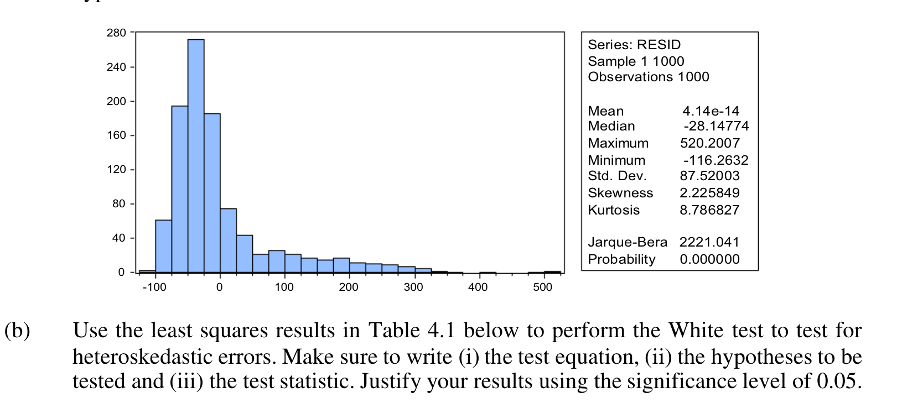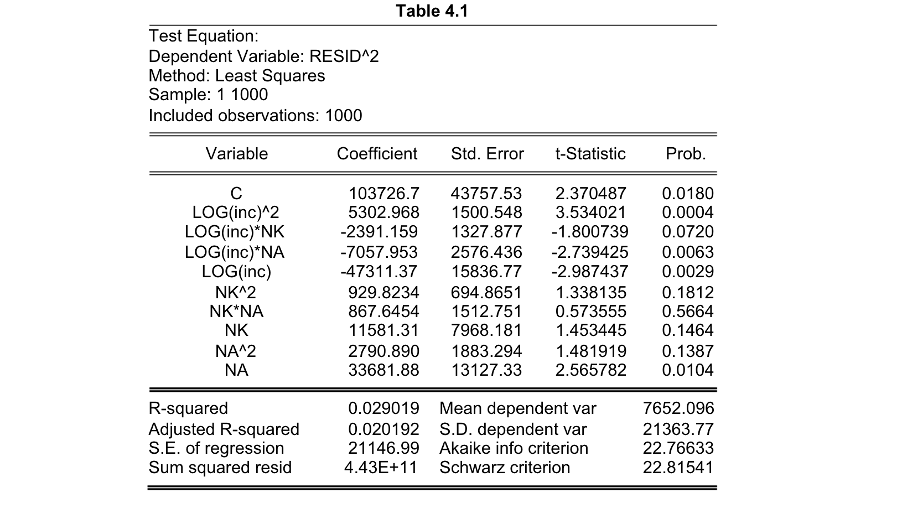Answered step by step
Verified Expert Solution
Question
1 Approved Answer
URGENT!!! Question 4 (3+5+4+3 = 15 marks) Consider the following expenditure function for transportation: trport; = B, +B, In(inc;)+BANK; +B.NA +e; (4.1) where trport =




URGENT!!!
Question 4 (3+5+4+3 = 15 marks) Consider the following expenditure function for transportation: trport; = B, +B, In(inc;)+BANK; +B.NA +e; (4.1) where trport = weekly household expenditure on transportation (in dollars). inc = weekly household income (in dollars). NK = number of children in the household. NA = number of adults in the household. (a) Equation (4.1) was estimated by least squares from a sample of 1000 households. The histogram for the residuals and some descriptive statistics are given below. Test whether the regression error is normally distributed. Make sure to specify the hypothesis. 280 Series: RESID Sample 1 1000 Observations 1000 240 200 160 - Mean Median Maximum Minimum Std. Dev. Skewness Kurtosis 4.14e-14 -28.14774 520.2007 -116.2632 87.52003 120 - 80 - 2.225849 8.786827 40 Jarque-Bera 2221.041 Probability 0.000000 0 -100 0 100 200 300 400 500 (b) Use the least squares results in Table 4.1 below to perform the White test to test for heteroskedastic errors. Make sure to write (i) the test equation, (ii) the hypotheses to be tested and (iii) the test statistic. Justify your results using the significance level of 0.05. Table 4.1 Test Equation: Dependent Variable: RESID^2 Method: Least Squares Sample: 1 1000 Included observations: 1000 Variable Coefficient Std. Error t-Statistic Prob. 103726.7 5302.968 -2391.159 -7057.953 -47311.37 929.8234 867.6454 11581.31 43757.53 1500.548 1327.877 2576.436 15836.77 LOG(inc)^2 LOG(inc)*NK LOG(inc) NA LOG(inc) NK^2 NK NA NK NA^2 NA 2.370487 3.534021 -1.800739 -2.739425 -2.987437 0.0180 0.0004 0.0720 0.0063 0.0029 0.1812 0.5664 0.1464 694.8651 1512.751 7968.181 1883.294 13127.33 1.338135 0.573555 1.453445 2790.890 33681.88 1.481919 2.565782 0.1387 0.0104 R-squared Adjusted R-squared S.E. of regression Sum squared resid 0.029019 Mean dependent var 0.020192 S.D. dependent var 21146.99 Akaike info criterion 4.43E+11 Schwarz criterion 7652.096 21363.77 22.76633 22.81541 (c) It is suspected that the error variance is of the form o=oexp{a, In (ing) +d3NK, +0:41 QAN} Explain how you would transform the model (4.1) to eliminate heteroskedasticity. (d) What are the consequences of heteroskedasticity? Question 4 (3+5+4+3 = 15 marks) Consider the following expenditure function for transportation: trport; = B, +B, In(inc;)+BANK; +B.NA +e; (4.1) where trport = weekly household expenditure on transportation (in dollars). inc = weekly household income (in dollars). NK = number of children in the household. NA = number of adults in the household. (a) Equation (4.1) was estimated by least squares from a sample of 1000 households. The histogram for the residuals and some descriptive statistics are given below. Test whether the regression error is normally distributed. Make sure to specify the hypothesis. 280 Series: RESID Sample 1 1000 Observations 1000 240 200 160 - Mean Median Maximum Minimum Std. Dev. Skewness Kurtosis 4.14e-14 -28.14774 520.2007 -116.2632 87.52003 120 - 80 - 2.225849 8.786827 40 Jarque-Bera 2221.041 Probability 0.000000 0 -100 0 100 200 300 400 500 (b) Use the least squares results in Table 4.1 below to perform the White test to test for heteroskedastic errors. Make sure to write (i) the test equation, (ii) the hypotheses to be tested and (iii) the test statistic. Justify your results using the significance level of 0.05. Table 4.1 Test Equation: Dependent Variable: RESID^2 Method: Least Squares Sample: 1 1000 Included observations: 1000 Variable Coefficient Std. Error t-Statistic Prob. 103726.7 5302.968 -2391.159 -7057.953 -47311.37 929.8234 867.6454 11581.31 43757.53 1500.548 1327.877 2576.436 15836.77 LOG(inc)^2 LOG(inc)*NK LOG(inc) NA LOG(inc) NK^2 NK NA NK NA^2 NA 2.370487 3.534021 -1.800739 -2.739425 -2.987437 0.0180 0.0004 0.0720 0.0063 0.0029 0.1812 0.5664 0.1464 694.8651 1512.751 7968.181 1883.294 13127.33 1.338135 0.573555 1.453445 2790.890 33681.88 1.481919 2.565782 0.1387 0.0104 R-squared Adjusted R-squared S.E. of regression Sum squared resid 0.029019 Mean dependent var 0.020192 S.D. dependent var 21146.99 Akaike info criterion 4.43E+11 Schwarz criterion 7652.096 21363.77 22.76633 22.81541 (c) It is suspected that the error variance is of the form o=oexp{a, In (ing) +d3NK, +0:41 QAN} Explain how you would transform the model (4.1) to eliminate heteroskedasticity. (d) What are the consequences of heteroskedasticityStep by Step Solution
There are 3 Steps involved in it
Step: 1

Get Instant Access to Expert-Tailored Solutions
See step-by-step solutions with expert insights and AI powered tools for academic success
Step: 2

Step: 3

Ace Your Homework with AI
Get the answers you need in no time with our AI-driven, step-by-step assistance
Get Started


